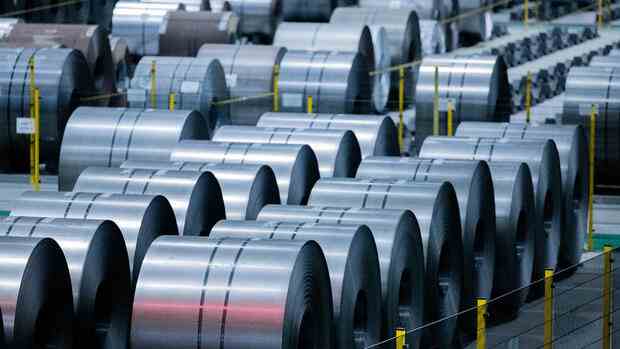Dusseldorf The largest independent steel trader in Europe creates CO2 transparency for almost all 200,000 products in the group portfolio. “Seven percent of global CO2 emissions come from steel production and processing,” Klöckner CEO Guido Kerkhoff told Handelsblatt.
Part of the solution to this problem is disclosing the CO2 emissions per tonne of steel in order “to bring more and more CO2-reduced steel onto the market,” says Kerkhoff.
As a new service from the steel trader, customers can now have the so-called CO2 footprint, also known as the “Product Carbon Footprint” (PCF), delivered for almost every Klöckner product, the company announced on Monday. The PCF records all of the product’s emissions – from raw material extraction to delivery to the customer.
With this, Klöckner wants to take another step towards decarbonization. According to experts, the certification of low-emission or zero-emission products is of central importance for the development of green value chains in industry. So far, considerations on how to establish comprehensible and globally recognized certification processes are only just beginning.
Top jobs of the day
Find the best jobs now and
be notified by email.
In October, the Steel Industry Association made a proposal for a label system to define low-emission or zero-emission steel. The proposal included a classification system and the PCF of the respective end product for steel customers – but this has not yet been implemented in concrete terms. Klöckner’s offer for measuring CO2 emissions is a first for the industry.
Companies show interest in the calculation tool
Klöckner had already developed a classification system for CO2-reduced steel products in the spring of last year. “We’re not waiting for all the market players to move, we’re boldly moving forward in the interests of our customers,” explains the CEO.
Klöckner CEO Guido Kerkhoff says: “If everyone doesn’t feel responsible for their upstream chains, it won’t work.”
(Photo: IMAGO/sepp spiegl)
The first customers to have the emissions of their purchased products broken down are Siemens Smart Infrastructure and the automotive supplier ZF. Demand is high, but Klöckner has not announced any other customers.
According to Kerkhoff, customers have not only expressed interest in the CO2-certified products, but also in the developed tool itself. The companies are faced with the problem of “having to penetrate their supply chains holistically – not just for one product, but for all of them,” reports the CEO. “If everyone doesn’t feel responsible for their upstream chains, it won’t work.”
For more than a year, emissions were determined across the entire value and supply chain. “The data collection spans supply chains that span almost the entire globe.”
>> Also read: Medium-sized companies initiate their energy transition and are held back by bureaucracy
Emission values could also be estimated for actors who were not so willing to share their data. “We supplement, if necessary, by using scientific data with maximum detail,” says Kerkhoff.
The company knows in which country the material is manufactured and which raw materials from which countries are used. There are external sources that can be used for this. Valid information directly from the manufacturer was often missing.
The values are calculated using the “Nexigen PCF algorithm”, which was developed by the steel trader and the Boston Consulting Group. The algorithm is certified by Tüv Süd – and is therefore independent.
Further processing of the amount of data is a challenge
However, the further processing options for the data have so far been a challenge: Because the huge amount of emissions determined not only has to be broken down for the product – but also be able to be identified by the customer during further processing.
“One of the challenges our customers face is the large number of materials and the associated CO2 emissions that flow into a complex end product,” explains Kerkhoff. “The question here is which technology, such as a blockchain, will be used in the long term.”
The CEO observes that the steel manufacturer’s customers are willing to pay for the measurement of the CO2 footprint. “The question that concerns our customers primarily is the issue of transparency: How much CO2 is actually in it?” says Kerkhoff. “A higher price is accepted because with our materials and know-how we can make a significant contribution to reducing our customers’ carbon footprint.”
More: Germany’s hydrogen strategy is a long time coming – companies are getting impatient
